I have made an agreement with the managing editor to write a brief operational history of the Rhodesian SAS then some specific actions. I am fortunate enough to have contacts who served in the SAS, one started in 61 with the second intake. I will also write about D squadron, South African Recces who volunteered to fight as Rhodesian soldiers in a classified operation not divulged until well after the war. Probably in the late 80s.
Then likely to explore some of SA's elite forces. Great thread BTW!! there is alot of stuff out there that is in peoples basements or in their aging mind. I want to get more and more of it before it disappears. It is a legitimate part of COIN history. It has mostly been ignored due to apartheid and politics. The soldiers didn't have the luxury of dwelling on such things......
Carried on a scale of 1:4 the FN MAG light machine gun allowed Rhodesian 4-man sticks (fire teams) to independently engage larger numbers of enemy in action. Being accepted by his commanders - and also especially by his peers - as a ruthlessly effective gunner was what the young troopies strove for. To illustrate this point I met one of my ex-troopies last year in the UK - 35 years after the fact - and he explained that when I took the gun away from him - for having two stoppages in a contact - it (the humiliation) was the worst thing that happened to him in his 7 years military service. Here is a photo of a young gunner about to deploy on a Fire Force call-out:
Note: In early 1978 the gunner was positioned in the starboard door (the aircraft's twin Brownings (or single FN MAG) were mounted in the port rear door) so that he could engage opportunity targets from the air - especially when coming in to land in a hot LZ. Inside next to the gunner was the stick commander who wore an aircraft headset to allow him to monitor the radio communications on the run in to the target.
Last edited by JMA; 07-13-2012 at 09:08 AM.
Can you email me at X ? Thanks. Dan
Last edited by davidbfpo; 07-14-2012 at 06:09 PM. Reason: Removed email on open display for privacy reasons, SWC prefers email are sent by PM and so done.
Time to go home... this time in the back of an Augusta Bell. This one a good farming boy who knew how to make that weapon 'talk'.
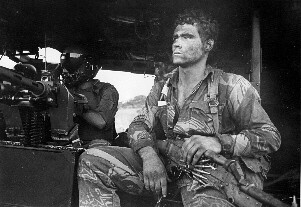
Due to the lack of helicopter capacity and the need for more troops to be delivered into the target area early to block escape routes it was decreed in early 1977 that the RLI would become parachute trained for this purpose. Trained and experienced soldiers were rotated through the Rhodesian Air Force 'Parachute Training School' with out any fuss as they were all battle proven and the air force trainers were interested only in one thing and that was to train the RLI in military parachuting. As an American has written:
Armies just can't help themselves and despite the tempo of the war intensifying time was found in later years to put soldiers (mainly those coming directly off recruit training) through 'pre para course PT'. (Obviously the PT staff were getting bored with all the soldiers going on ops, but instead of giving them soldiers to play with the PT staff should have been packed off to the bush to get some trigger time in.)... a group of us reported to New Sarum airbase for Rhodesian Para Course 75/77. Though I was parachute-qualified I didn’t mind going through Rhodesia’s course taught by the Air Force. The course was only two weeks long with the second week consisting of nine jumps. Unlike the US Army’s jump school, there was no physical training associated with the course and the technical training was easy. There were no 34-foot or 250-foot towers and no mindless screwing with the future paras.
This is how a gunner kitted up for a jump. The photo is of troops waiting to emplane for a fire force deployment. (Note: the Dak - C-47 had more air speed than the Alouette helicopters so would normally get airborne some time after the choppers.)
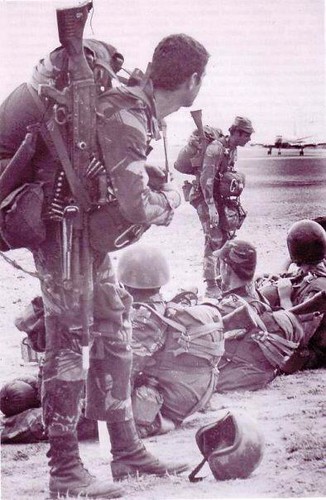
Last edited by JMA; 07-15-2012 at 06:48 AM.
... gunners told, "we are going to need those guns today, go make sure they are clean and ready, we will brief you later".
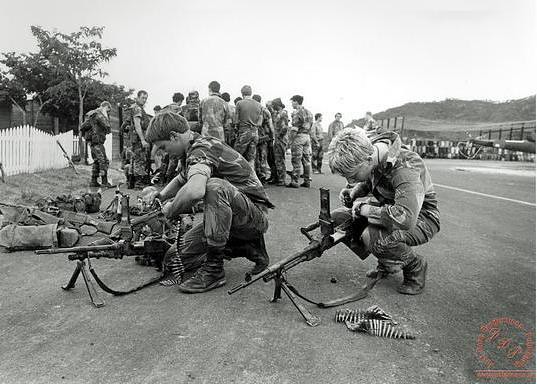
... another farmer's son. Young, strong and committed... a penny for his (after action) thoughts?
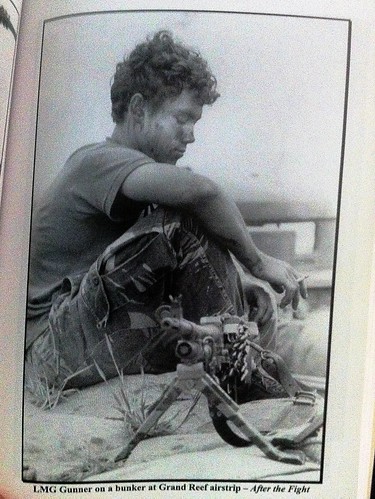
... a corporal at the time (later a sergeant and awarded the BCR - Bronze Cross of Rhodesia) takes an after action 'smoke break' after some Fire Force action.
Note: radio handset on the right shoulder... must be left handed as the left hand was never to leave hold of the pistol grip of the rifle. The two magazines were welded together and the sling swivels removed from the rifle to prevent any rattle.
... the poster boy. Copied from a photo which was used as a recruiting poster. South African man giant, Marius Marais, wielded the MAG like the rest of us mortals used rifles. Don't be fooled by the smile... or the peace sign:
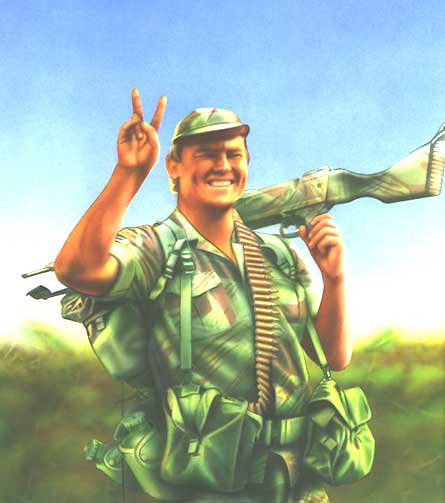
... don't piss a jumbo off.
Extract from the book - which in turn is an extract from Dennis Croukamp's book:
The Bush War In Rhodesia: The Extraordinary Combat Memoir of a Rhodesian Reconnaissance Specialist
... Shortly before dark, the five-man patrol appeared. One member of the patrol was covered in blood down one side of his head and body, and the Lance Corporal had his arm in a sling. Everyone tried to explain at once about what had transpired, but because everyone was talking at the same time trying to give their version of events, it was somewhat confusing at first.
After a while Penrose told everyone to shut up and we were then given a blow by blow run-down of what had taken place. Walking down a game trail along the thickly wooded riverbank with the Stick Commander, L/Cpl Penrose (Pinball), in front, the patrol observed a light aircraft repeatedly buzzing an area slightly to the east and ahead of them. With some concern about the low-flying plane disturbing and upsetting the larger game, Pinball was being a little more cautious than usual.
Even so, going around a bend where a large bush had obscured the trail ahead, he came face to face with a tuskless elephant. The elephant started charging and Pinball immediately did an about turn and tried to run away from the elephant. Pinball reckoned the problem came about because he had to run around the bush that he previously had walked around. The elephant simply ran through it. Pinball said that as he ran he felt its trunk running up and down his back as it felt for a grip. With the patrol’s change of direction he was now at the back of it, with Jumbo in hot pursuit.
It did not take long for the beast to grab him around the body, at first lifting him as if in a circus act, before pushing him into the ground, fortunately soft ground. Pinball voicing his objections to this unwanted and rather rough treatment drew the attention of his pal and companion, Pieta Pitman. Pitman responded to the screams for help and ran back to assist Pinball. Doing a bit of a dogleg, he approached the animal from the side.
For fear of shooting and injuring his pal who was now nearly under the elephant’s feet, he boldly moved up and gave the elephant a swift blow to its side using the butt of his rifle, but without any response from the elephant. When a second blow to its side also brought no reaction from the elephant, Pitman stepped forward and gave it a further whack in its ear hole.
He said that when he stepped forward, the creature’s one eye was looking directly at him and it scared the $hit out of him. It looked both cross and evil. When the blow to its ear landed, the elephant let its grounded victim go and side swiped the rescuer, flinging him over a bush, so that he landed some ten metres away. Pitman landed in a cloud of dust, completely winded. Getting his breath back he called to Pinball as the latter had gone quiet and he did not know if Pinball was all right. The elephant by now had wandered off.
Once the two had reunited and were satisfied that the danger had passed, they started looking for the others. The delay at getting to the RV was because it took the two of them over an hour to find the other three patrol members...
1 February 1979:
“It is with great pride that we honour today those men of the Regiment who have made the supreme sacrifice and dedicate this statue to their memory.
“This statue, to be known as “The Trooper”, represents the courage and endurance of highly-skilled men who fight the enemy with dedication and professionalism.”
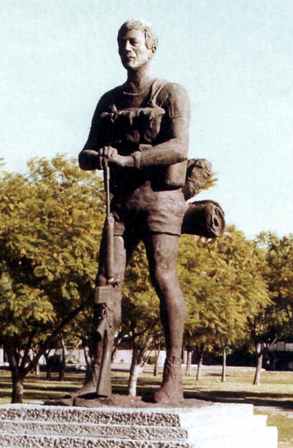
In his final resting place:RLI Memorial: The Trooper
by Ken Reed (last RSM of the RLI)
Conceived by Lt. Col. Derry MacIntyre in 1970 and implemented by Lt. Col. Ian Bate and RSM Ken Reed on the 1st of February 1979 The Trooper statue was unveiled on its plinth which was erected in the centre of the Holy Ground Cranborne Barracks Salisbury on the 18th birthday of the RLI.
The bronze statue funded by the RLI RA with donations from the Rhodesian public and others from around the world was sculpted by Captain Mike Blackman from a selection of photographs taken by him. Some Troopers in various types of dress were organized for him to photograph outside 2 Commando. He brought the proofs back with his choice for the statue which was the unposed photo of Trooper Wayne Hannekom. We naturally objected as the photo clearly showed the Trooper standing with his hands held over the muzzle of his rifle contrary to all weapon handling procedures. Capt. Blackman was adamant that this was the pose he was going to sculpt as it was completely natural and in fact how the men stood around in the bush. He got his way and it was the correct decision.
The statue was cast by Fiorelli Fiorini in his foundry which was situated just off the Beatrice Road near the tobacco floors. There was a rumour it was cast from cartridge cases, some were delivered to be incorporated in the bronze mixture.
The Trooper was unveiled and dedicated with a parade attended by the whole Battalion which required a juggling of Operational commitment by Army HQ. This meant there was very little time for organisation and rehearsals. The parade was kept simple and was very well attended by dignitaries, ERE members and the general public. The Trooper was unveiled by Trooper Phillips SCR from Support Commando who was our most highly decorated soldier at that time. The dedication was given by Padre Bill Blakeway and wreaths were laid by selected personnel on behalf of the RLI RA, The Battalion and Commandos.
As independence approached it was realised that The Trooper the Colours and other RLI memorabilia were in imminent danger so a plan was formed by the CO Lt.Col. Charlie Aust, RSM Ken Reed and the RLI RA to spirit away the Regiments honours to the South African War Museum in Johannesburg. Negotiations began and despite the politically sensitive nature were successfully concluded with Major General Minaar Fourie of the South African Defence Force. The crated Trooper and other memorabilia were airlifted from Fylde Air force Base near Hartley and received by the SA War Museum.
Moving The Trooper presented several problems Because of the mode of transport and the size of the crates we were permitted. It could not be moved upright, laying it down would have buckled its legs due to the weight of its base. After advice from Mr. Fiorini it was decided to cut the base off at the ankles so the Engineers came with their equipment took it down and crated it for us.
Initially housed in an outbuilding and covered with blankets at the SA War Museum, permission was obtained from the RLI RA by the Rhodesian Association of South Africa (RASA) for The Trooper to appear at the Rand Easter Show in 1985 in public view and visited by many former Rhodesians. The Trooper was returned to the Museum where it was placed in a more prominent position, no longer subject to its former sensitivities.
It was later decided to move The Trooper to the United Kingdom and the Rhodesian Army Association (RAA) through Brigadier David Heppenstal, was asked to act as its custodian. The Trooper and other memorabilia were flown out of RSA and stored in a Fleet Air Arm hanger. After further negotiations The Trooper was moved to the British Empire and Commonwealth Museum (BECM) in Bristol where it was agreed to be displayed.
Unfortunately this did not happen and in 2006 with The Trooper damaged, the Executive Committee of the revitalised RLI RA sought a more appropriate home for the Trooper. In 2007 Jerry Strong then Chairman of the RLI RA met with Lord Salisbury to begin the consultation process of where and how to site The Trooper at Hatfield House north of London.
Later in 2007 a delegation consisting of Brigadier John “Digger” Essex-Clarke, Martyn Hudson, Shaun Ryan and Chris Pearce of the RLI RA, John Wynne-Hopkins RAA and the BECM Trust’s Liaison Officer met with Lord Salisbury to select a site and at the same time received permission to lay up the Colours in the Family Chapel. Pressured by Martyn Hudson and the RAA Museum Trust led by Pat Lawless The Trooper was repaired by the BECM, placed on a new plinth and transported to the banks of the River Lee in the Hatfield Estate.
The Troopers journey from Rhodesia to the banks of the River Lee on the Hatfield Estate was made possible by the courage, stamina, resourcefulness generosity and dedication of all those who assisted in reclaiming back that small part of history which will forever be remembered as Rhodesia.
The Trooper now stands proudly as a lasting Memorial to the men who served with the RLI and those who died for their country Rhodesia.
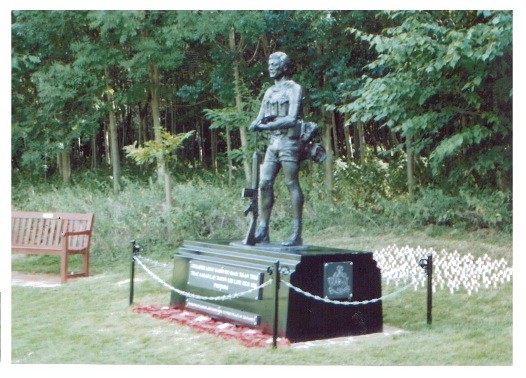
A poem:
The Troopie
He stood erect and proud.
Was unveiled before the crowd,
Representing what could not be said,
A memorial to the brave and dead.
A symbol of courage for all to see,
A salute to soldiers whose souls fly free.
The pride of the Rhodesian Light Infantry,
The man of bronze, the Immortal "Troopie".
He weathered sun and wind and rain.
He suffered not, he felt no pain.
Standing at ease and looking ahead.
He saw not the tears we shed.
A symbol of courage for all to see,
A salute to soldiers whose souls fly free.
The pride of the Rhodesian Light Infantry,
The man of bronze, the immortal "Troopie".
Where he stood is now an empty space.
Nothing else could ever take his place.
Yet he lives on in each and every heart.
In the lives of which he was a part.
Gone is the symbol of courage for all to see,
A salute to soldiers whose souls fly free.
Gone is the pride of the Rhodesian Light Infantry,
Gone is the man of bronze, the immortal "Troopie".
by Mrs. Jenny Ayling, from the RLI Cheetah 1980 Souvenir Edition.
Rededication of The Trooper Hatfield, UK, 2008
Dedication speech by Lt Col JCW (Charlie) Aust - last CO of the RLI:
It is, indeed an honour and privilege to say a few words during this unique and deeply moving ceremony.
On reflection I realize and believe that it is a special time for personal thought. Our joint memories, our thoughts, our personal meditation this day, would fill the pages of military history with the most incredible unique and awe inspiring tales of war and peace.
Before us stands the symbol of our past ----- a sepulcher of our beloved Regiment our comrades, our fallen. Yes ---- these are personal thoughts and memories we cannot share.
It is essential that at the outset I speak on ALL our behalf, to express our deepest appreciation and gratitude to the Marques of Salisbury for the truly incredible and generous gifts he has given us and our Regiment. His permission to lay up our Colors in his private Chapel and to erect our Memorial on his private Estate is remarkable. The Marques' family is deeply embedded in the history of our once wonderful land - let us not forget ‘Hatfield', the suburb home of our Cranborne Barracks.
Let us not forget our Capital City and its title.
I personally remember, my friend Lord Salisbury's brother. Lord Richard Cecil with deep affection - he who died in action on the front line of our war. He who enjoyed our Country and its people. He is held in deep and respected memory today.
Thank you Lord Salisbury. We will remain eternally grateful for your kindness. And we do thank all your staff for their wonderful work to assist us.
We welcome especially this day our new Patron Gen Ron Reid Daly - a founder member of the RLI and a legend of our time and war.
I must also take this opportunity to speak on all our behalf in thanking Martyn Hudson for his truly outstanding efforts in organizing the relocation, repair and erection of our beloved Troopie and indeed for all his incredible work in arranging this unique weekend and all the events. His conduct reflects unbelievable determination, energy and commitment. Martyn, we all salute you in admiration and gratitude and indeed all who assisted you.
Our Chairman, Buttens Buttenshaw, who so sadly was unable to attend reminded me of Col Tufty Bate's statement when we unveiled the Troopie so many years ago ------‘that whilst the breath of one RLI member still existed the statue would remain'. Tufty who initiated the idea for a Regimental War memorial would be so proud this day. Let us thank him for this foresight..
Now I do, again on all our behalf thank all who have done so much to help us. As the years go by and we get older memories may fade but this sacred corner will always ignite that unique torch of military memory.
I do offer our gratitude to all our comrades from across the globe who could not attend who have also done so much for our Association. Let us cast aside differences of opinion which have arisen. Let us cast aside any anger. We thank and think of all our leaders and members across the world that are absent today. Our thoughts are with you.
As the ceremony proceeds I will once again think in sadness and gladness of that unique Regiment. The Troopie will again reveal to the world, a parachute Commando Unit of UNBELIEVABLE ability. A Regiment with nicknames which reveal a character and ability second to none. ‘The Incredibles', ‘The Saints' -‘The Green and White'. A band of brothers drawn together from all the corners of the world. Who can forget or, indeed, even repeat that incorrigible sense of frolic and fun and leg pulling that devastating efficiency in battle, that unbelievable courage and commitment.
I have learnt that comrades in war bring the human closer to his companion, than any other life - style. It is a unique blending of the human race. With gathering maturity our Regiment bred incredible, irreplaceable characters. Rank was deeply respected. Life was extremely tough and hard on so many occasions , yet true friendship jelled between all ranks.
The loss of our comrades initiates (and always will) deep sadness, yet deep pride. Before us today stands our anchor, our joint symbol of deep respect. As the veil falls we will see again he who stood upon the Holy Ground. He, we always saluted in passing --- our beloved Troopie He is now with us forever in safety.
I am reminded, in closing, of a well known song of the 70's. A song reworded by a tough RLI ouen. A song we sang together when enjoying R and R or stand down with a few grogs. I am moved to quote the words which have never ever left me.
"Far have I traveled on land and through sky.
Dark are the valleys, the mountains are green
But oh our Colours fly higher than high
For we are the men of the RLI
Now one lies wounded. He's so far from home.
All of the Troopies they pray for his soul
As life leaves him. He hears a heavenly choir.
As they carry him back to the RLI."
Let us remember those immortal words:
They shall not grow old as we who are left grow old.
Age, shall not wear them. Nor the years condemn.
At the going down of the sun and in the morning we will remember them.
May I end with a 5 word prayer, as I ended the final speech before the Regiment marched off the Parade Ground at Cranborne and into history in 1980.
MAY GOD BLESS THE RLI
Thank you
Last edited by JMA; 07-19-2012 at 02:50 PM.
Lynx : Rhodesian designation for 21 x Reims Cessna FTB337G Milirole delivered to the Rhodesian Air Force. Normal weapons load being twin .303 Brownings, two pods of 37mm SNEB rockets and two 15 gal Frantan (frangible tank - locally made Napalm). They would come in as close as required... the trick was that the pilots were attached to the various Fire Forces for a period of years and they got to know, train and fight with the same RLI soldiers over a long period. They were not just a callsign in the sky... we could put a face to the voice.

A painting of the Angel of Mercy (or Death - depending on whose side you were on):
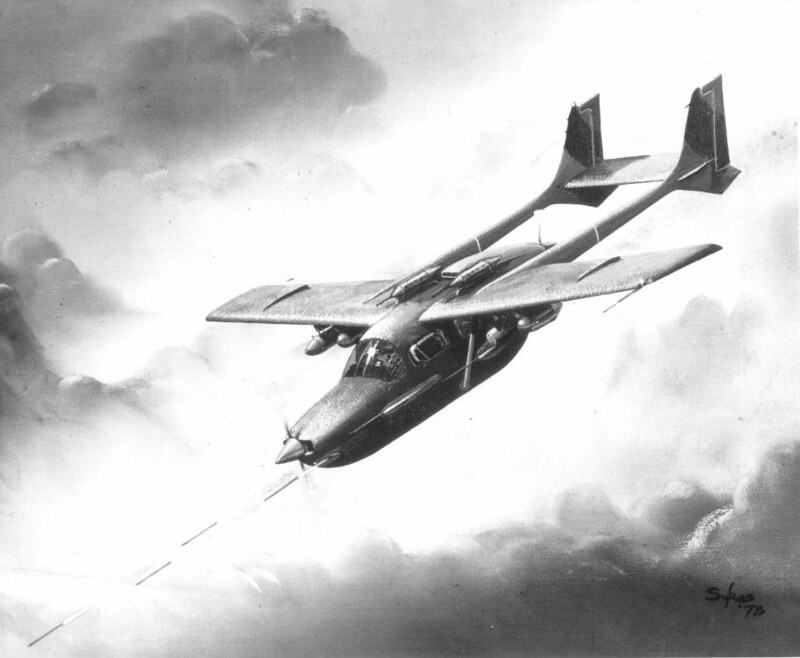
The death of great RLI soldier Al Tourle while running a tracking course in 1972...
Al Tourle survived the night but died as dawn was breaking and the CASEVAC chopper was approaching. None of the Rhodesian helicopters had a night flying capability.... Just before catching Colin that evening, we heard the roar of lions in close proximity on the ridge just above us to the south of the riverbed. We had decided that we would call it a day, find some water and a suitable place to base up for the night. We filled our water bottles and set up our bivvies on level ground above the riverbed. The area was typical heavily wooded mopani trees/savannah, elephant grass and jesse bush vegetation. In other words thick and dense! We were wet and cold from the rainstorm that had just passed over.
... Al had agreed that we could have a fire that night. A very rare treat I might tell you! As light was falling, Colin and I collected some leadwood and started the fire next to two big rocks. The call of the lions echoed through the still of the evening setting. In the meantime Al and Andr were making comms with Pete and the base back at Kariba. They could not get through to Kariba as the relay station had been brought down for a changeover late afternoon. While this was being effected, a storm had hit the relay position, which forced them to abort the exercise until the next morning. The storm was heading towards Kariba.
... After some time around the fire, Andre and Colin retired to their bivvy for the night. Al and I positioned ourselves on the bigger of the two rocks and started to reminisce about the RLI days. The fire had died down and only the glow of the coals remained. It was about 1930hrs (we did not have watches), it was pitch black and there was a light guti (misty rain) falling on the trees above us. The droplets from the leaves were falling to the ground. Mosquitoes had taken over from where the mopani flies had left off. It was quite noisy in its own special way. Suddenly the stillness of the night erupted with the roar of lions upon us. They had crept up on us from behind totally undetected, a feat that has left an indelible impression on me all my life. The one lion landed right on Als back while the other bumped sides with it and was thrown slightly off line. We were both knocked off the rock towards the coals of the fire. Immediately I scrambled to grab my rifle, which was at the opening of my bivvy. When I turned I could just make out that the one lion had Al by the neck and was dragging him between its legs away into the thick scrub. I instinctively double tapped a few rounds over the top of the lion. It dropped Al and disappeared in the darkness.
Andre and Clive had both joined me by now and we went forward to where Als body lay limply. He was unconscious and lying on his side with his head at right angles. As Andre and I were checking his vital signs the lions came charging back at us. We all grabbed our rifles and discharged a few rounds in the direction of the lions. They immediately dispersed under the volley of fire and ran off into the night. Andre and I turned our attention back to Al. He was just starting to come round, bleeding heavily from his chest, neck and back. The lion that landed on him had locked its jaws around Als neck, its upper jaw piercing his chest and lower back, in the process breaking his neck. We rolled him gently onto his back, moving his head as we rolled him over. I could already feel that his lower body was completely limp. We broke open our medical pack and start to dress the open wounds. As we were doing this Al uttered his first few words, Where am I, what happened?
Bookmarks